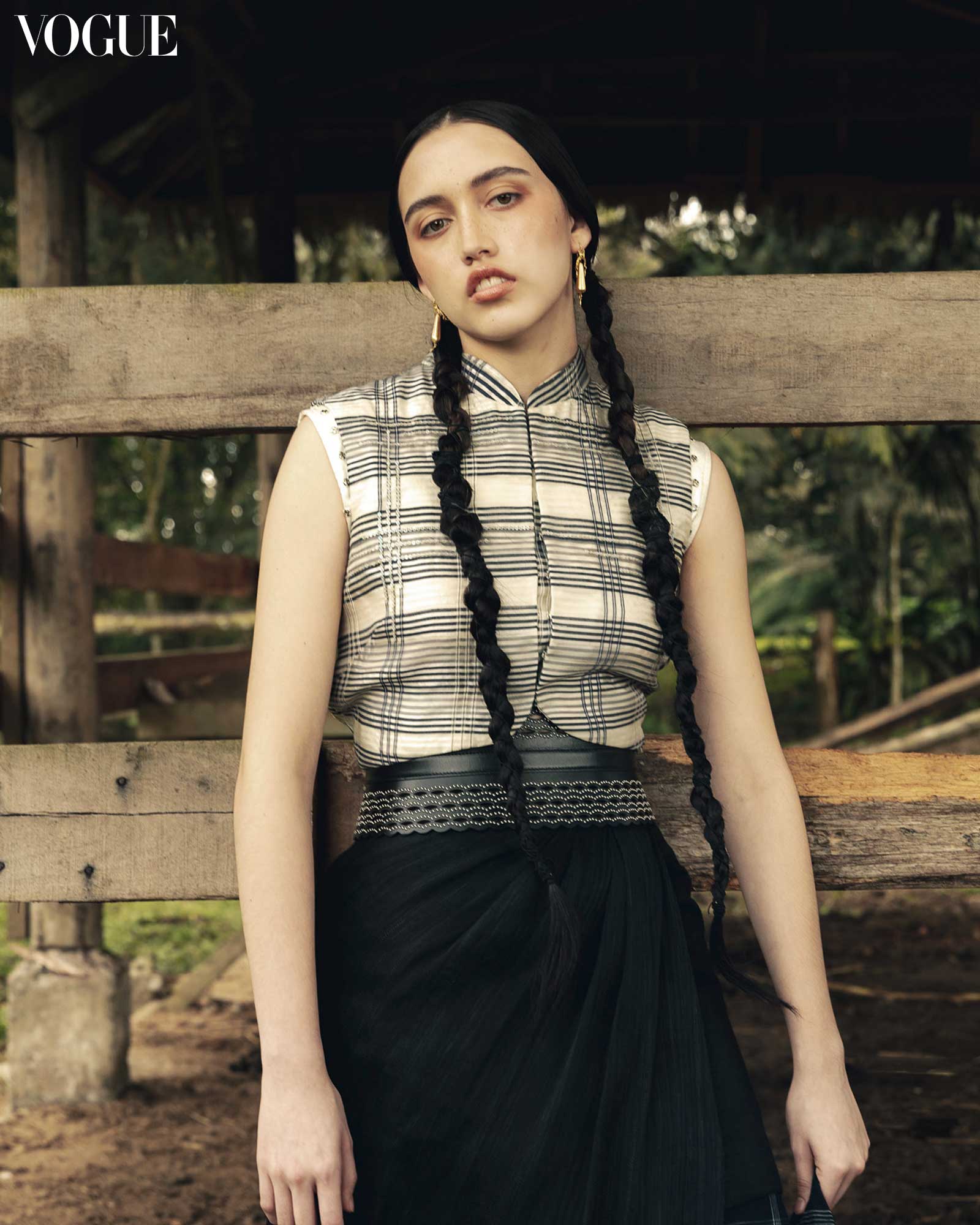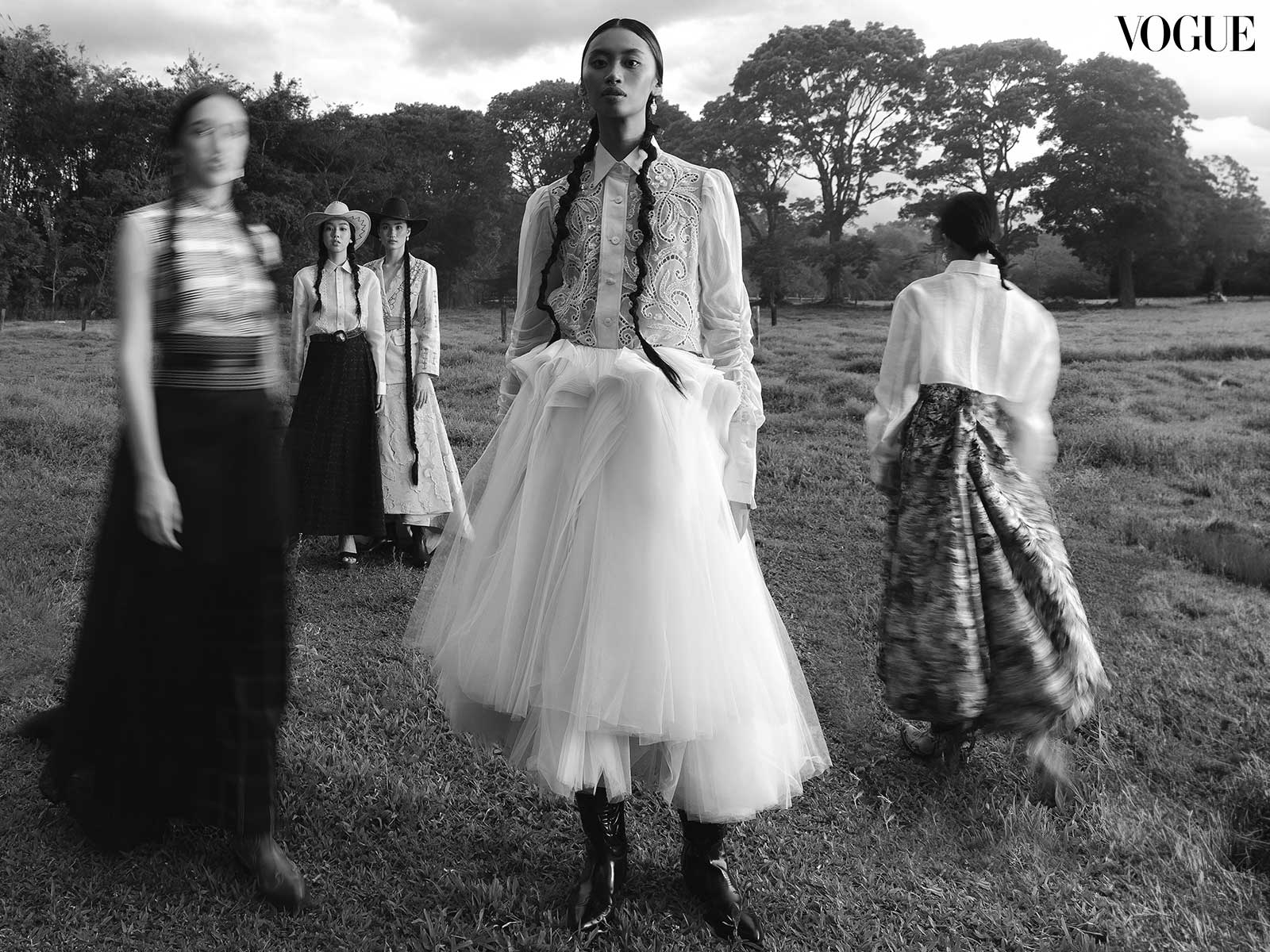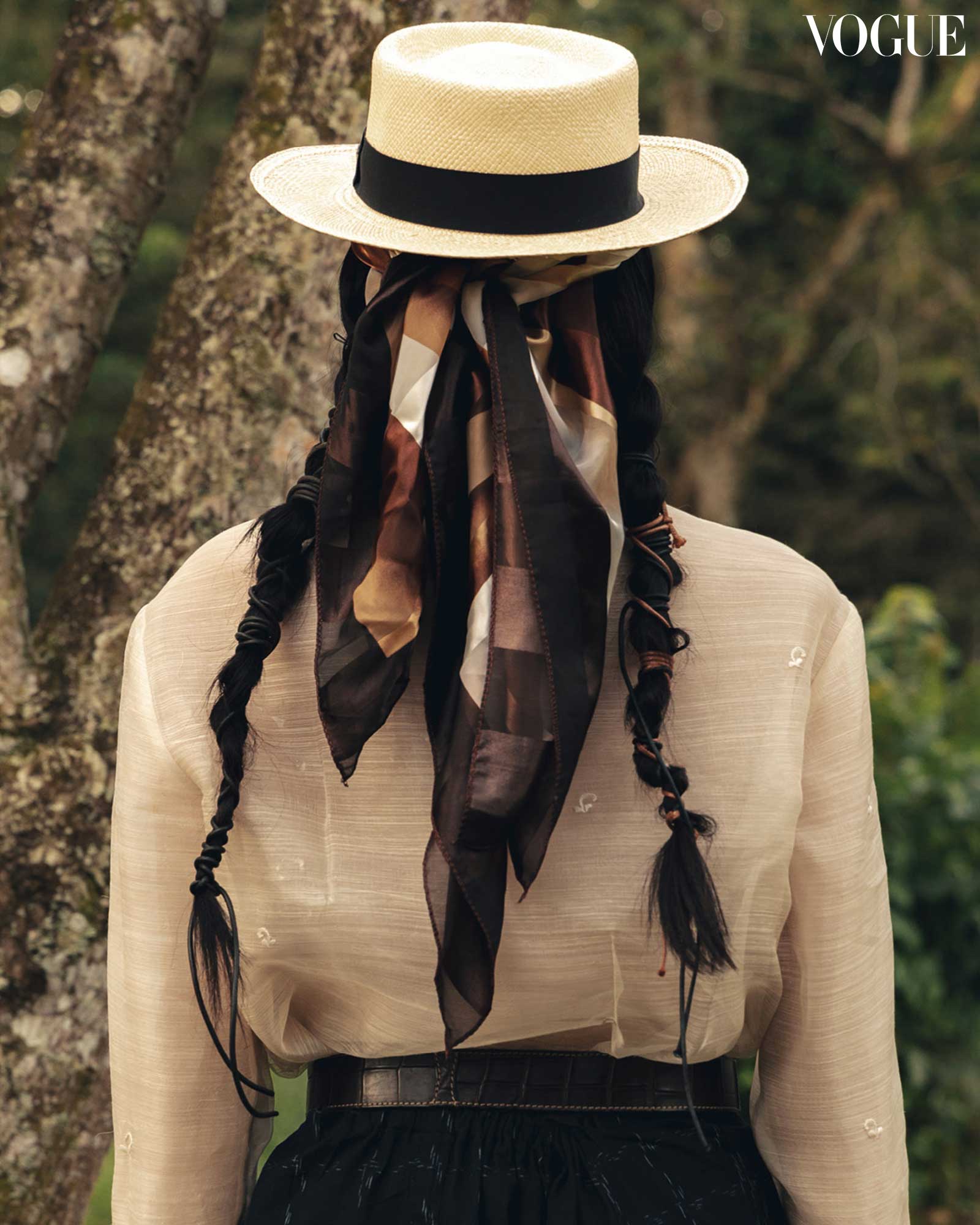ABDUL GAFFAR top, JOREL ESPINA skirt, and GANNI boots. Photographed by Borgy Angeles for the May 2024 Issue of Vogue Philippines.
Fashion’s new frontier might not be “new” after all, but it’s bigger, and more inclusive, than we realize.
It’s not just Beyoncé; everyone is going country these days. From Pharrell Williams’s Wild West-inflected men’s collection for Louis Vuitton to Lana Del Rey announcing her pivot to country music, “Cowboy Carter” is only the tip of the iceberg for the full-blown Western renaissance we’ve yet to see more of. But this resurgence isn’t anything new.
It has seeped into fashion and popular media before: in 2016, when Alessandro Michele riffed on nudie suits and ten-gallon hats during his tenure at Gucci; in 2017, when Raf Simons and Maria Grazia Chiuri put Western-inspired ensembles on the Calvin Klein and Dior runways respectively; and in 2019, when Lil Nas X led what stan culture likes to remember as the “Yeehaw Agenda,” via “Old Town Road” and a Cardi B feature on the track “Rodeo.”
Even Solange and Lizzo dipped their toes into the aesthetic, and there was the chart-topping layered crooning of Kacey Musgraves, who opened for Harry Styles’s Madison Square Garden leg of his tour, that gave the time its backing. Designers gave the agenda a wardrobe to match, presented on the runways of Telfar Clemens, Pyer Moss, and LaQuan Smith.

But hints of Western wear appeared even before that, when the early-aughts response to Brokeback Mountain was a Marc Jacobs and Wrangler collaboration and a speckling on the runways, or when Thierry Mugler presented a pair of bedazzled ruby-red chaps at his Haute Couture 1992 show.
This is all to say, “It never really went away in fashion,” says Dr. Sonya Abrego, a fashion historian and the author of Westernwear: Postwar American Fashion and Culture. “There’s always ups and downs in Western style when it becomes more on trend and when it doesn’t.” A part of that, she notes, is that’s just the way fashion works. Some of what we’ve been seeing time and again “is a continuation,” she continues. “But I also think there’s a lot of new people on board now, right? I think it’s bigger and in different ways, partly thanks to Beyoncé recently, but not just that.”
For this year’s spur in interest, we, of course, have Beyoncé to thank. Her influence is tangible. According to a recent New York Times article, the fashion search engine Lyst had tracked a spike in searches for Western-related clothing and accessories following the release of “Cowboy Carter,” specifically for cowboy boots, Levi’s jeans, and the keyword “cowboy.”
But aside from her wide-reaching influence on a global audience, what’s most interesting is that—in the hands of artists like Beyoncé and Lil Nas X, designers like Pharrell Williams and Telfar Clemens, and, really, anyone who can get ahold of a good pair of cowboy boots—Western style is reinventing the notions that popularized it in the first place. Today, it has become a genre that feeds itself. Beyoncé might be leading the charge, but anyone can hold the torch.

Western wear was typically presented “as kind of one thing,” Dr. Abrego expands, “as usually privileging white males.” As goes the stereotype perpetuated by the golden age Westerns fronted by John Wayne and Gary Cooper. “But now we are starting to see not only more people of color and queer people in the mix, but also just more playfulness with the style itself.”
Now Western wear has become more akin to a canvas, an evolving tapestry that a new wave of designers is imbuing their own personal inclinations and messaging into. We saw that at Pharrell’s grand staging of his fall 2024 Vuitton show, where Dakota and Lakota tribes contributed to create accessories, and which almost evoked a sort of childlike wonder in its overt expressions. Or the past few seasons that Willy Chavarria has presented, showing his more multifaceted, all-encompassing form of Americana, almost all topped by cowboy hats.
It’s a form, or more accurately, a new attitude, that even Philippine fashion can tap into. In the main fashion editorial of Vogue Philippines’ May 2024 Issue, wide-brimmed gaucho hats, belted waistcoats, and cowboy boots are tailored to the northern Mindanao grasslands, its stables and free-roaming pastures framed by those whispering mountains that line the horizon.
Worn expressions of femininity (which made references to the flounced prairie skirts and ruffled tops associated with the West) reclaim what is traditionally perceived as masculine. The barong, formalwear typically worn by men in the Philippines, is seen here in cropped and raw-hemmed versions, fitted close to the body. A high-necked capelet cut from the same piña fabric features a thin overlay of embossed Philippine brass, a piece selected because it evokes the region’s and the country’s rich cultural heritage, but also because it expresses a kind of regality: “an overt expression of a woman’s power,” writes Ticia Almazan.

Here, the fashion of Filipino designers Joey Samson, Abdul Gaffar, Ken Samudio, Mich Dulce, and more carries the new attitude sparking over at New York and Paris Fashion Weeks, and seeding itself into pop culture in increments over time. With it, there are no more barriers when it comes to who can wear the style and how, and it’s manifest even in the history of the style as a whole.
“One of the things I think is interesting that comes up in a lot of articles and conversations that I see in media, and just in life, is kind of this idea of like, who is a ‘real cowboy’ or ‘What is a real Western style?’ and all these arguments in and around authenticity,” Dr. Abrego says. “I get, on one hand, that’s coming from people who live and work. That’s their lifestyle. That’s their work. That’s their culture.”
She continues, “But if you look at the history of the style and the clothes, you see fashionable treatments and fashionable versions of Western wear all the way to the 19th century. So one thing that I would like people to maybe think instead of making this really strict binary between fashionable and functional, or like ‘real’ Western, to kind of think that maybe those influenced each other in different ways.”
This personalization and this sense of play that is riffed on a style emblematic of strength, grit, and swagger is embedded in its origins, and how it’s persisted through time. “It’s part of that identity, and I think that working people still can care about style and do care about style. And you see that in the West just as much as anywhere else.” It’s fashion’s wide-open frontier, and just about anyone can explore.
